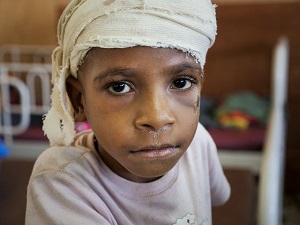Geneva Palais briefing note on the situation of children affected by the earthquakes in Papua New Guinea
This is a summary of what was said by Christophe Boulierac, UNICEF spokesperson in Geneva – to whom quoted text may be attributed – at the press briefing at the Palais des Nations in Geneva on Apr 24.

Five-year-old Douglas Jacob, who was injured on 26 February 2018 by falling rocks which hit him on the head when a 7.5 magnitude earthquake struck Papua New Guinea, sits on a bed as he recovers at a hospital in Mount Hagen, Papua New Guinea, 12 March 2018.
In Papua New Guinea, almost 2 months after the 7.5 magnitude earthquake that hit the country, children remain disproportionately affected by the disaster.
The Government estimates 270,000 people are in need of urgent assistance, including 125,000 children, of which 55,000 are children under five years old.
Beyond the direct effects of the earthquake, including death, injury or the loss of parents, children are also at high risk from increases in waterborne and vaccine preventable diseases due to water contamination from landslides, poor sanitation and personal hygiene management; and already low immunization coverage in the Highlands region.
According to our most recent report, a total of 11,041 households (42,577 people) remain displaced.
Impact of the earthquakes on children’s health and malnutrition
- Health facilities are reporting an increasing number of cases of watery diarrhoea. The Provincial Health Authority in Southern Highlands Province reported 180 cases of diarrhea just this morning as well as 26 cases and 2 deaths related to whooping cough.
- The outbreak of vaccine preventable diseases also remains a major challenge in the health response in communities where primary health care services don’t exist either due to breakdown of health infrastructure or issues of inaccessibility to health facilities.
- 55 per cent of health facilities in Hela and Southern Highlands urgently need access to safe water sources. And most of the health facilities that re-opened can only attend to emergency services.
- It is worth noting that low immunization coverage was an existing condition prior to the earthquake with several provinces in the highlands already facing malaria and measles outbreaks. According to the National Department of Health (NDOH), about 70-80 per cent of children in the severely-affected provinces are not protected against preventable diseases
- Before the emergency, around half of children under-five were chronically malnourished - the highest rate in Asia and the Pacific and fourth worst in the world - and around 15 per cent of children suffer from acute malnutrition, with 2.6 per cent considered severe. Severe wasting is estimated to increase up to 4 percent.
Impact of the earthquakes on children’s safety, wellbeing and mental health
- Children who were already impacted by the earthquakes and subsequent unsettling aftershocks are now confronted with safety issues due to violence and conflict.
- The security situation in Hela Province deteriorated within two weeks of the first earthquake. Rival groups armed with bush knives, machetes and guns killed people and burned houses near Tari town, the headquarters of the province where aid workers are based.
- This is having a profound negative impact on the mental health of children who may be faced with serious consequences on brain development and overall wellbeing.
- Before the earthquakes, children in PNG were already at high risk of violence and abuse. Available data indicate that girls and boys in PNG experience some of the highest rates of violence in Asia-Pacific region. About 75 per cent of children report experiences of physical abuse and about 80 per cent experience emotional abuse during their lifetime.
Impact of the earthquakes on education
- Preliminary Government assessments found that about half of the schools in affected areas were at least partially damaged.
- Some 15,000 children and teachers need support to resume their class as normal. Although schools are reopened, many children are still afraid to return to school.
UNICEF response
To date, UNICEF has delivered 23 metric tons of life-saving supplies including tents and tarpaulins, water purification tablets, hygiene kits, and learning kits. A few days after the earthquakes, UNICEF distributed vaccines to the affected communities to protect some 31,700 children against measles and rubella, pertussis, pneumonia and tuberculosis.
Currently, UNICEF is working to save lives and protect the well-being of affected children and families by making sure that:
- Children receive the emergency therapeutic food and milk they need to survive, Basic health services, including vaccines (jointly with WHO, Government churches), reach children in affected communities
- Children have safe water to drink
- Children receive psychosocial support in safe child friendly spaces.
Yet despite progress, providing assistance continues to be very challenging. Many earthquake-hit communities are very hard to reach, with little or no road access. Insecurity and tribal fighting in the worst-hit areas also hinders humanitarian response.
Efforts to protect vulnerable children need to be stepped up and sustained. Acting now will help reduce the risk of major humanitarian emergencies in the coming months. The longer we wait, the costlier the response and recovery will be. At the same time, resource mobilization has been limited due to little attention from global community and donor countries
UNICEF is seeking $14.6 million USD to provide humanitarian and recovery assistance to children and families affected by the earthquake over the next nine months.
Source:United Nations Children's Fund
- 279 reads
Human Rights
Fostering a More Humane World: The 28th Eurasian Economic Summi

Conscience, Hope, and Action: Keys to Global Peace and Sustainability

Ringing FOWPAL’s Peace Bell for the World:Nobel Peace Prize Laureates’ Visions and Actions

Protecting the World’s Cultural Diversity for a Sustainable Future

Puppet Show I International Friendship Day 2020

